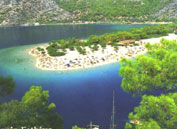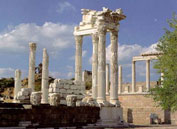Because of its location, Turkey was a region through which ancient Asian Turkish culture moved into Europe, and also a window of Western culture opening to meet the east.
Turkey is surrounded by the Mediterranean Aegean and Black Sea which connects the country to the whole world. Three of the four - Black, Aegean and Mediterranean Sea – flow into the Atlantic Ocean. The Sea of Marmara, between the Black Sea and the Aegean, is within the borders of Turkey. Because of these long coastal borders and the bridge between Asia and Europe, Turkey has been the centre of major commercial and migration routes.
Turkey is considered a high-altitude country, as the mountains cover the majority of the land, there is a significant area which is made up of plains, plateaus and sediment areas. These geographical variations mean that the climate is also varied, and affects the location of settlements and economic conditions.
Turkey is separated into seven major geographic regions according to climate, natural plantation and distribution of the agricultural activities.
 |
 |
A BRIEF ON HISTORY
Turkey is one of the most ancient settlement areas of the world as four seasons are encountered on this fruitful land on which thousands of natural plant grows.
At the archeological excavations in the Karain cave near Antalya, various traces relevant with the lower, intermediate and upper periods of Paleolithic Age were found. The Paleolithic Age is generally accepted to start two million years before the present time and ended ten thousand years ago.
The most developed Neolithic Age settlement of the Ancient Near-east and Aegean is Çatalhöyük, which is 52 km southeast of Konya Province. Anatolia has entered Bronze Age by the end of 4000 BC.
The inscribed history period of Anatolia began by 1950 BC. The Hittites has founded the first state governed by the central system in Anatolia at 1750 BC. The traces and the art work belonging to Hittites are obtained from the archeological excavations carried in Boğazköy, Alacahöyük, Eskiyapar, İnandık, Maşathöyük, Kargamış, Zincirli, Arslantepe, Karatepe, Sakçagözü and in various places which were under the reign of Hittites.
After destroying the Hittite Empire, Frigs have gained the dominance over some regions of Anatolia between 1200-700 BC. Their government center was Gordion, at the vicinity of Ankara. Urartus, founding a state around Van Lake with their capital as Tuşba (Van) at the beginning of 1000 BC has added important works of art to our cultural heritage.
By the end of the 2000 BC, as a result of the Dorian migrations, the first Hellenist colonies begin to settle at the western parts of Anatolia. The effect of Ionian civilization had significantly increased in Western Anatolia after the 1050 BC. Karia, Lycia and Lydia Civilizations had their brightest and most advanced periods between VII- VI. Centuries BC. The Lydians –the inventor of the currency in the form of coins- founded a state at the central parts of the Aegean Region around 700 BC with the capital city of Sardes. Although the Lydian Civilization was destroyed by Persians in 546 BC it continued to effect Anatolia until 300 BC. During the reign of Persians in the western Anatolia, Greco- Persian Style art works were established.
After the invasion of Anatolia by Alexander the Great, the Hellenistic Period (333-30 BC) began. During this period, the cities of the Aegean Region was ornamented by architectural art works. After 30 BC, there was a major cultural improvement under the reign of Roman Empire. As the Roman Empire was divided into two in 395, the Byzantine period began in Anatolia and the art works were adapted to this culture. Parallel to the spreading of the Christianity, there was a significant increase in the religious structures and works. The Byzantine period ended in 1453, after the conquest of Istanbul by the Turks.
The Turks begin to settle in Anatolia starting from the beginning of the XI. Century during the period of Great Seljuk Empire. During the period of the Seljuks (1075-1318), the older cities were repaired and ornamented with new structures and also new settlements were founded. The priority was set to the religious architecture required by Islam, education institutions and hospitals.
The Ottomans, which founded a state in 1299 to became an empire, had obtained the unification in Anatolia in the period of Fatih Sultan Mehmet. During the ascension period which begins with Fatih Sultan Mehmet, the borders of the empire reached from the inner parts of Iran to Central Europe and from Crimea to Northern Africa. The Ottoman Empire carried its own culture to these newly conquered lands while absorbing the admired elements of the local culture into its own. Therefore, a rich cultural mosaic is founded.
Starting from the XVIII. Century, The effects of European culture on the Ottoman culture is seen.
After the Turkish Independence War under the command of Atatürk, Republic of Turkey was founded in 29 October 1923. The Republic of Turkey took over a rich cultural heritage from the Ottoman Empire. Atatürk initiated important studies about enlightening, preserving and presenting of this rich heritage. He founded Turkish Language and History Institutions. He founded and flourished education in Faculty of Language, History and Geography and reverted Topkapı Palace and Ayasofya (Hagia Sophia) into museums.
Turkey has united its natural beauties with its cultural heritages and therefore made great improvements in the tourism field. The remains and works of ancient cultures other than Turkish background are preserved and great importance is paid to these art works. The Ephesus Arthemis Temple and Halikarnassos Bodrum Mausoleum, which are counted among the seven wonders of the world, were once inside the borders of Turkey. Sadly,the remaining parts of these two unique wonders are displayed at the major museums all around the world.
Links on Turkey
- http://www.kultur.gov.tr